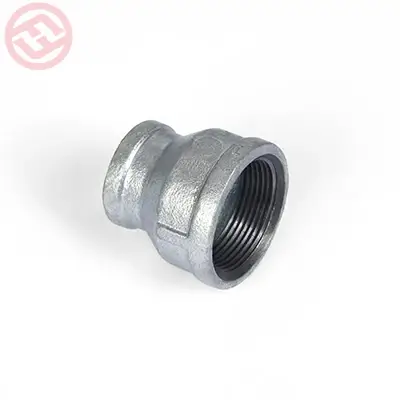Malleable iron fittings have inherent properties that provide some resistance to corrosion, although they might not be as corrosion-resistant as some other materials like stainless steel or certain alloys.
Here are ways malleable iron fittings resist corrosion:
- Composition: Malleable iron contains a significant amount of iron and small percentages of carbon and silicon. Its composition contributes to its natural resistance against corrosion to some extent.
- Surface Coatings: Applying protective coatings such as zinc plating, galvanization, or epoxy coatings to malleable iron fittings enhances their resistance to corrosion. These coatings act as a barrier, preventing direct contact between the iron and corrosive elements in the environment.
- Passivation: Some surface treatments involve passivating the iron, creating a protective oxide layer on the surface that helps inhibit corrosion.
- Environmentally Controlled Factors: Malleable iron fittings tend to resist corrosion better in environments with lower humidity, fewer corrosive chemicals, and less exposure to harsh elements. Proper storage and installation away from highly corrosive environments also contribute to their longevity.
- Maintenance: Regular maintenance, inspections, and timely repairs or reapplications of protective coatings can significantly prolong the lifespan of malleable iron fittings by preventing or addressing corrosion.
Despite these measures, it’s important to note that malleable iron fittings might still be susceptible to corrosion in certain conditions, especially in aggressive environments containing high levels of moisture, chemicals, malleable black iron fittings or salt. Over time, even with protective coatings, these fittings might experience some level of corrosion, which can impact their longevity and structural integrity.
For applications where corrosion resistance is a primary concern, selecting alternative materials or implementing additional protective measures might be necessary. It’s crucial to consider the specific environmental factors and demands of the application when choosing fittings to ensure optimal performance and durability.
How do you ensure leak-free connections with malleable black iron fittings?
Ensuring leak-free connections with malleable black iron fittings involves several steps and considerations during installation:
- Proper Preparation: Thoroughly clean the pipe ends and the interior of the fittings to remove any dirt, debris, or rust that could compromise the seal. Smooth, clean surfaces are crucial for a tight seal.
- Sealant Application: Apply an appropriate sealant or thread compound to the male threads of the pipe before assembly. This helps fill gaps between the threads and creates a tight seal. Ensure the sealant used is compatible with malleable black iron and suitable for the intended application.
- Thread Engagement: Thread the pipes into the fittings by rotating them clockwise until they reach the end of the threads. Proper engagement ensures a secure fit without gaps that could lead to leaks.
- Avoid Over-Tightening: Use the correct tools and follow recommended torque values to tighten the fittings adequately without over-tightening. Over-tightening can damage the threads or distort the fittings, causing leaks.
- Check for Alignment: Verify that the fittings and pipes are properly aligned and oriented according to the system layout and specifications. Misaligned fittings can lead to stress and potential leaks.
- Inspection for Leaks: After assembly, conduct a visual inspection for any signs of leakage. Pressure testing the system might also be necessary to ensure there are no leaks at the joints.
- Addressing Leaks: If any leaks are detected, make necessary adjustments by tightening the fittings further (without over-tightening) or reapplying sealant as needed.
- Follow Standards and Guidelines: Adhere to industry standards, manufacturer recommendations, and local building codes throughout the installation process to ensure compliance and safety.
- Proper Support and Secure Attachment: Ensure that the fittings are properly supported and securely attached to the structure or system. Stress or movement due to inadequate support can lead to leaks over time.
- Recordkeeping and Documentation: Maintain accurate records of the installation process, including the fittings used, torque values applied, and any testing conducted. This documentation can be valuable for future maintenance or troubleshooting.
By following these steps and best practices, you can help ensure leak-free connections with malleable black iron fittings, contributing to the integrity and reliability of the piping system they are a part of.
